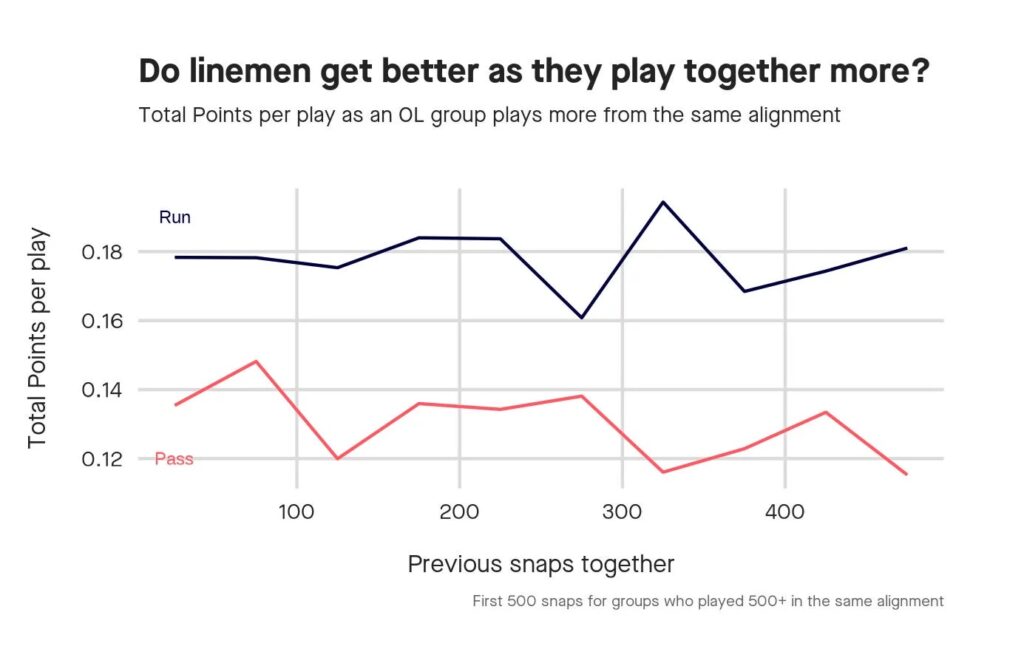Photo: Brian Rothmuller/Icon Sportswire
They say football is the ultimate team sport and all, and one of the reasons for that is the nature of offensive line play. Linemen have to work as a unit to fend off pass rushers in the pass game and block the front in the run game.
It’s a funny thing, though—there actually isn’t that much continuity, even if you don’t worry about where players are aligned. Less than a third of teams play the same five players more than half the time in a given season. Very few groups will ever—across multiple seasons—accumulate even a single season’s worth of snaps with the same alignment.
Offensive lines with consistent personnel perform well. This seems obvious for two reasons: experience with teammates is good, and if you have good starters you don’t want to replace them. The combination of these effects produces an obvious result:
Snap rates, Total Points by most common offensive line grouping, 2024
| Rk | Team | Snap% | TP/play Rk |
| 1 | 49ers | 93% | 6 |
| 2 | Bills | 93% | 3 |
| 3 | Chiefs | 74% | 18 |
| 4 | Packers | 69% | 10 |
| 5 | Dolphins | 68% | 2 |
| 28 | Steelers | 29% | 20 |
| 29 | Raiders | 28% | 31 |
| 30 | Colts | 28% | 15 |
| 31 | Browns | 24% | 24 |
| 32 | Saints | 17% | 13 |
I don’t think you’ll need convincing that this phenomenon is true at large, so we’ll cut to the chase: can we address the question of whether time together drives better performance, or is it more that you just have good players and want to keep them on the field as much as you can?
Methodology
A pretty straightforward way to assess this is to look at how lineups perform over the span of hundreds of snaps together.
Importantly, we can’t just compare the performance of groups in their 100th snap to the performance of groups in their 1,000th, because bad groups don’t make it to a thousand. But we can identify the groups that make it to some volume threshold and only compare those, so we know that we’re in an apples-to-apples situation.
There have been 86 groups of linemen who have started together since 2018 and played at least 500 snaps together at any point.
(This should underscore how unlikely continuity is, by the way—that’s fewer than three lineups per team playing just half a season together, over the span of more than seven years.)
If we look at groups that played at the same positions at least that much, the number is 82, so basically the same size. Let’s use that population because we can feel more confident that there would be a continuity effect when the players are in the same spots each time.
Taking the performance of just these groups and averaging their Total Points per play in the running game and the passing game over time, we can see if there is an effect of experience playing together.
And it turns out, there really isn’t much of anything.
What Did We Learn?

From what we can find here, at least, playing together more doesn’t show better performance in either the run game or pass game. We’d want more than half a season’s worth of snaps together to judge this, ideally, but with so few groups actually getting to that point it’s not so relevant what that level of shared experience is worth.
To further convince us that the apparent experience effect is mostly just a difference in quality, we can compare the average production of players in this population to the average of everyone else. If the more experienced groups are generally composed of better players, the average performance of those players before that experience was accumulated should be better.
And that’s pretty much what we find.
To measure this, we can take the sum of each player’s Total Points in their previous season’s worth of games prior to starting a stretch with a new line combination. The sum in this case serves the dual purpose of capturing experience and quality, where players who have a track record of success will be rated higher.
Adding the previous-16-game Total Points for each player in the group, the groups that made it to 500 snaps together averaged a total of 62 Pass Blocking Total Points and 51 Run Blocking Total Points prior to their first snap together. All other groups averaged a total of 51 Pass Blocking Total Points and 46 Run Blocking Total Points. That suggests there is an experience/quality difference for the players in those more successful groups.
Last word
We shouldn’t be so bold to claim “offensive line continuity is a myth”, because working together builds efficiency in any walk of life. And there might be some other approaches that could assess the question more robustly—like measuring how removing a player from the lineup affects the performance of the other four players.
But the results we’ve found do suggest that such an effect is more marginal than we might think, at least in part because there aren’t actually that many opportunities for groups to get a lot of experience together. This also makes a decent argument for the value of plugging in linemen via free agency, because individual quality seems to drive value more than stability.
